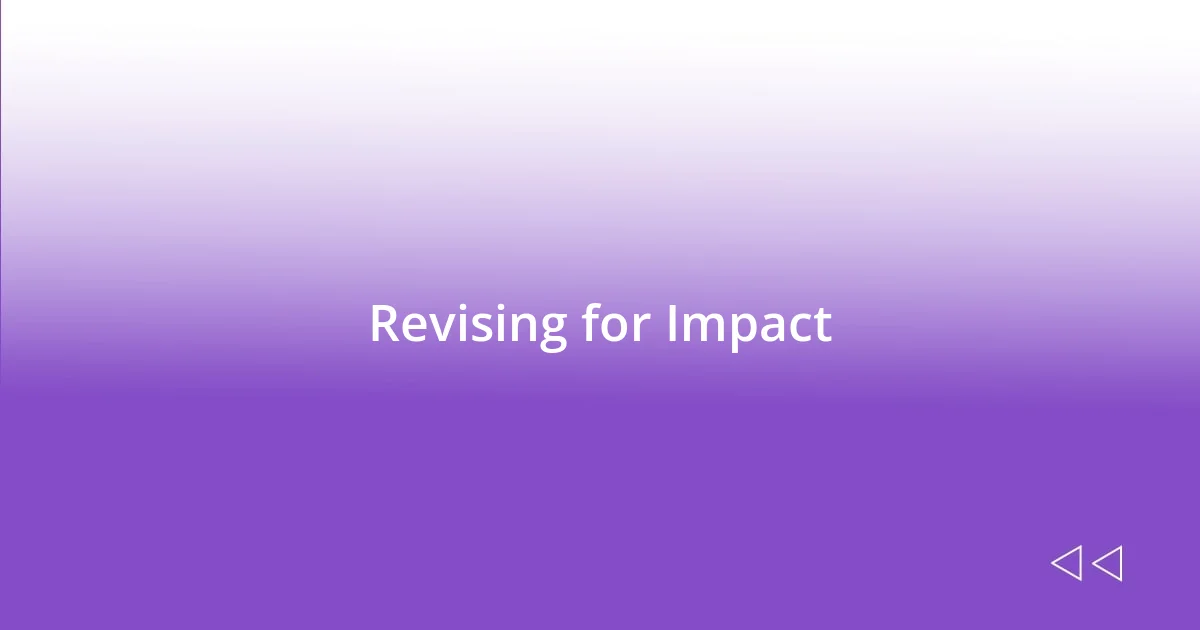Key takeaways:
- Understanding and crafting character arcs are essential for creating emotionally engaging stories, reflecting real-life transformations and struggles.
- Identifying character flaws enriches their journey and fosters relatability, allowing readers to connect through shared imperfections and personal growth.
- Revising for impact involves refining emotional resonance in characters’ arcs, ensuring that each moment effectively engages readers and highlights character development.

Understanding Character Arcs
Understanding character arcs is essential for creating compelling stories. I remember when I first delved into writing; I was so focused on plots that I overlooked how vital characters’ transformations are. It’s through these arcs that our readers connect emotionally—who doesn’t love a good redemption story or watching a hero evolve into their best self?
Character arcs typically follow a framework, usually involving stages of change—think of it as a character’s personal journey. Each stage not only serves to develop the character but also reflects their internal struggles and triumphs. For instance, when I was working on a piece about a lost soul finding their purpose, I realized the arc was really about their confrontation with fear. Have you ever felt the pull of a significant change in your life? That’s the kind of emotional resonance a well-crafted character arc can evoke.
What intrigues me most about character arcs is how they mirror real-life experiences. We all go through transformations, often influenced by our struggles, relationships, and choices. In my own life, I’ve experienced moments where I felt utterly different after overcoming challenges. This understanding helps me portray authentic character arcs that resonate deeply with readers. How could I not draw from my own experiences to shape these characters? Embracing this connection allows for richer storytelling and more impactful characters.

Identifying Character Flaws
Identifying character flaws is a fundamental step in creating a relatable and dynamic character. Consider your favorite books or movies—often, it’s the flaws that make characters unforgettable. I recall a character I wrote who was overly prideful, and it was fascinating to see how that flaw led to their downfall. Pride often blinds us, doesn’t it? In real life and fiction alike, it’s these imperfections that serve as a catalyst for growth.
When I dive into a character’s flaws, I look for both the obvious shortcomings and the subtle nuances that reveal deeper layers. For instance, a character may seem arrogant on the surface, but digging deeper could uncover insecurities driving that arrogance. This duality makes them more complex. Reflecting on my own experiences, I’ve stumbled into situations where my fear of vulnerability came off as aloofness, illustrating how flaws can often mask deeper truths.
Recognizing these flaws not only shapes a character’s journey but also enriches the reader’s experience. I remember when I had to choose between two characters: one was a risk-taker, and the other was paralyzed by fear. The latter, despite their flaws, offered a more profound exploration of overcoming personal battles. Delving into character flaws invites readers to reflect on their shortcomings, creating a genuine connection and prompting introspection.
| Character Flaw | Impact on Arc |
|---|---|
| Pride | Leads to isolation and downfall |
| Arrogance | Masks insecurities, creates conflict |
| Fear | Hinders growth, incites transformation |

Creating Transformational Experiences
Creating transformational experiences for characters is about evoking genuine emotions and showcasing significant changes over time. I once crafted a character who started as a hopeless skeptic, only to gradually embrace faith in others. This evolution wasn’t just about shifting beliefs; it stemmed from heartfelt moments, like the instant when they chose to save an old friend, realizing that vulnerability could lead to deeper connections. It’s those pivotal moments, sparked by personal crises or unexpected acts of bravery, that truly transform a character and resonate with readers.
To create these rich transformational experiences, consider these key elements:
- Conflict: Introduce challenges that force characters to confront their beliefs and fears.
- Support: A mentor or friend can guide characters through their journey, providing emotional depth.
- Climactic Decision: Build to a moment where the character must choose between old habits and new paths.
- Reflection: Allow characters to reflect on their experiences, helping readers grasp the magnitude of their change.
- Emotional Resonance: Use relatable emotions, so readers can connect personally with the transformation.
Crafting these elements allows readers to experience the journey alongside the character, making their transformation feel earned and profound.

Mapping Emotional Journeys
Mapping the emotional journey of a character is like tracing a winding path, with each twist and turn revealing deeper aspects of their psyche. I remember when I outlined a character who struggled with anger management. I plotted his reactions to different triggers, and each reaction linked back to a pivotal moment in his past—like losing his father during his teenage years. Isn’t it fascinating how our past shapes our present responses?
As I mapped out these emotional traumas, I began to see my character not just as someone with flaws but as a person grappling with real pain. It struck me that mapping isn’t just about pinpointing emotions; it’s about understanding how they evolve. I once had a mentor who would always ask, “What is this character afraid of?” I found that addressing this question made their emotional journey more relatable, as fear often drives our decisions in life—we can all connect with that.
Bringing emotional arcs to life requires attention to the subtle shifts in a character’s feelings throughout the narrative. For instance, I created a character whose initial grief turned into anger, which then morphed into acceptance. Mapping this shift highlighted not just a change in emotion but a deeper understanding of resilience. When I reflect on this process, I often ask myself, how can I ensure that every emotional bump along the journey feels authentic and earned? I truly believe that mapping these journeys is essential for readers to not only understand characters but to resonate with their struggles and triumphs.

Developing Supporting Characters
Developing supporting characters is an intricate part of enhancing the main character’s arc. I recall once designing a side character who served as a confidant; their unwavering loyalty emphasized the protagonist’s isolation. It made me ponder: how can we use supporting characters to illuminate the main character’s journey without overshadowing them?
As I fleshed out this confidant, I found it important to give them their own motivations and flaws. It’s like watching a dance where both partners bring their strengths and weaknesses to the floor, enriching the overall performance. For example, I created a mentor figure who, despite their wisdom, struggled with an inability to let go of past regrets. This dynamic not only deepened the main character’s understanding of resilience but also raised the stakes emotionally. Isn’t it intriguing how a well-developed side character can propel the protagonist toward growth?
I also believe that conversations between supporting characters can reveal unseen layers of the main character. I often write scenes where a supporting character challenges the protagonist’s views, sparking internal conflict. This dynamic isn’t just a plot device—it’s a chance to showcase complex relationships and elevate the narrative. By weaving in these intricate layers, I aim to make both the main character and their support system feel like real people, ultimately creating a richer and more engaging story.

Revising for Impact
Revising is where the magic truly happens, and understanding character arcs is crucial during this stage. I recall a time when I felt my protagonist’s growth wasn’t landing quite right, so I took a step back and revisited key scenes. I found that tightening the dialogue revealed layers of vulnerability that significantly deepened their journey. Isn’t it amazing how often the simplest tweaks can transform a moment from flat to profoundly impactful?
One approach I’ve adopted in my revisions is to focus on emotional resonance. For instance, I once revised a climactic encounter where my character faced their greatest fear. Initially, it felt rushed, lacking emotional weight. By slowing the pace, I allowed the character’s internal struggle to shine, creating a moment that resonated with readers. I’ve come to realize that revising for impact means asking myself whether each scene truly engages the reader’s emotions—are they feeling what the character is feeling?
Furthermore, I’ve learned to be ruthless in cutting extraneous details that dilute a character’s arc. I remember working on a draft where I had woven in backstory that seemed essential at the time. However, during revisions, I recognized it detracted from the core struggle. By removing those layers, I enhanced the clarity of my character’s emotional journey. It’s a delicate balance—how do we keep the essence while ensuring each word pulls its weight? This refining process not only clarifies the character’s path but also strengthens the narrative as a whole.

Applying Character Arcs in Writing
When applying character arcs in writing, I often find myself reflecting on how early decisions shape the trajectory of a character’s growth. Take, for example, my recent work where I introduced a decision point for my character that transformed everything. I had them choose between love and duty, and that moment catalyzed not just their arc but also the arcs of several supporting characters. Isn’t it fascinating how a single choice can ripple through a story?
As I develop these arcs, I pay close attention to the small, seemingly mundane moments that reveal growth. For instance, I once described a character learning to stand up for themselves not through grand speeches but during everyday interactions, like when they asserted their opinion in a casual meeting. I found that those quieter moments often resonate more with readers. Don’t you think it’s those little victories that build up a character’s strength over time?
Another technique I’ve embraced is using metaphors to illustrate character arcs—like a flower slowly blooming. In one story, I depicted my character’s progression through her relationship with a garden she initially neglected. As she began to nurture it, her own self-discovery blossomed alongside the flowers. It’s moments like these that highlight how character arcs can be intertwined with their environment. What better way to show growth than through a vivid transformation we can all appreciate?














